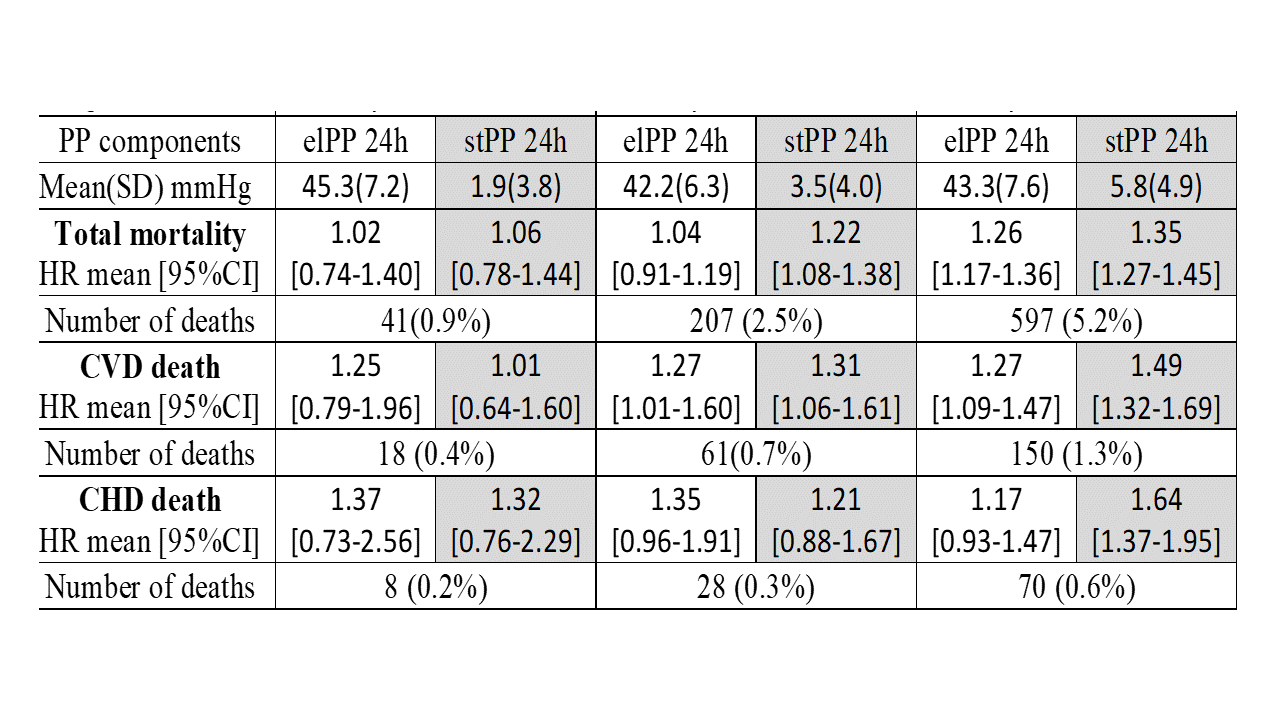Final ID: P-313
Diastolic to Systolic Arterial stiffening has Greater Prognostic Power than Diastolic Stiffness in 20-60 Years Old Patients Undergoing 24-Hour Ambulatory Blood Pressure Monitoring
Abstract Body: The 24-hour ambulatory pulse pressure (PP), can be expressed as a sum of two ‘PP components’: ‘elastic’ PP (elPP) and ‘stiffening’ PP (stPP) associated, respectively, with arterial stiffness at the diastolic pressure (somewhat equivalent to pulse wave velocity being measured in the diastole), and the relative stiffness change from the diastolic- to the systolic pressure. Here we assess and compare the hazard ratio (HR) of elPP and stPP for outcomes in a large cohort of young and middle-age patients.
We analyzed adequate quality 24h ambulatory blood pressure monitoring records from the Spanish Ambulatory Blood Pressure Registry. For standard deviation(SD), K=SD(SBP)/SD(DBP), elPP=PPxln(K)/(K-1) and stPP=PP-elPP. HRs were determined for age 20-40, 41-50, and 51-60 years, using Cox regression models applied to standardized elPP & stPP (combined), adjusted for age, sex, BMI, smoking status, diabetes, dyslipidemia, mean DBP, pulse rate, SD(SBP), antihypertensive treatment, and previous cardiovascular disease (CVD). The endpoints were total mortality, and death from CVD, or coronary heart disease (CHD).
Of the 24,260 patients mean age (SD) 48.0(9.0) years, 34% male] 845 deaths occurred during period of 9.6(2.2) years. The Table shows that mean elPP slightly decreased from younger to older age, while stPP strongly increased. At age 41-60 years the adjusted HRs of stPP appeared significant and greater than those of elPP for almost all cases. The most contributing adjustors in the Cox regression were smoking, for all age classes, and sex for age over 40 years.
Thus, the stiffening component may have greater predictive power than the elastic component for total mortality, and CVD&CHD death, in middle-age patients.
We analyzed adequate quality 24h ambulatory blood pressure monitoring records from the Spanish Ambulatory Blood Pressure Registry. For standard deviation(SD), K=SD(SBP)/SD(DBP), elPP=PPxln(K)/(K-1) and stPP=PP-elPP. HRs were determined for age 20-40, 41-50, and 51-60 years, using Cox regression models applied to standardized elPP & stPP (combined), adjusted for age, sex, BMI, smoking status, diabetes, dyslipidemia, mean DBP, pulse rate, SD(SBP), antihypertensive treatment, and previous cardiovascular disease (CVD). The endpoints were total mortality, and death from CVD, or coronary heart disease (CHD).
Of the 24,260 patients mean age (SD) 48.0(9.0) years, 34% male] 845 deaths occurred during period of 9.6(2.2) years. The Table shows that mean elPP slightly decreased from younger to older age, while stPP strongly increased. At age 41-60 years the adjusted HRs of stPP appeared significant and greater than those of elPP for almost all cases. The most contributing adjustors in the Cox regression were smoking, for all age classes, and sex for age over 40 years.
Thus, the stiffening component may have greater predictive power than the elastic component for total mortality, and CVD&CHD death, in middle-age patients.
More abstracts on this topic:
A 50% or Greater Reduction in LDL-Cholesterol Is Associated with Improved Long-Term Outcomes and Lower Health Care Utilization After Myocardial Infarction - a SWEDEHEART study
Reitan Christian, Watanabe Alexandre, Bash Lori, Galvain Thibaut, Arnet Urs, Jernberg Tomas
A Comparison of Outcomes in Heart Failure Patients with and without Iron Deficiency Anemia: A National Database AnalysisBess Olva, Quevedo Ramirez Andres, Shaka Abdultawab, Oredipe Omotola, Bello Jeremiah, Shaka Hafeez

